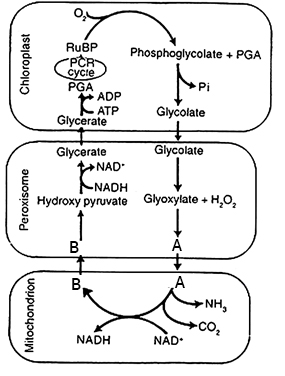The products of non-cyclic photophosphorylation include:
1.
ATP and P700
2.
ATP and NADPH
3.
ADP and NADP
4.
P700 and P680

To unlock all the explanations of 38 chapters you need to be enrolled in MasterClass Course.

To unlock all the explanations of 38 chapters you need to be enrolled in MasterClass Course.
The and photosynthesis pathways are so called because the initial carbon fixation product in them are respectively:
| 1. | pyruvate; malate |
| 2. | malate; pyruvate |
| 3. | 3-phosphoglycerate; oxaloacetic acid |
| 4. | glyceraldehyde 3-phosphate; phospho-enol-pyruvate (PEP) |

To unlock all the explanations of 38 chapters you need to be enrolled in MasterClass Course.

To unlock all the explanations of 38 chapters you need to be enrolled in MasterClass Course.
The extra ATP required [as compared to NADPH] in Calvin cycle comes from:
| 1. | photosystem II | 2. | photosystem I |
| 3. | cyclic electron flow | 4. | non cyclic electron flow |

To unlock all the explanations of 38 chapters you need to be enrolled in MasterClass Course.

To unlock all the explanations of 38 chapters you need to be enrolled in MasterClass Course.
In the given simplified diagram of the Calvin Cycle,
ATP is utilized at points:
1. A and B only
2. A and C only
3. B and C only
4. A, B and C
Light dependent reactions are so called because they require light:
| 1. | to provide electrons for the process |
| 2. | to split the water molecule |
| 3. | to impart energy to the electrons in the reaction center |
| 4. | to hydrolyse ATP molecules |
The chronological order of organelles involved in the photorespiration cycle is:
| 1. | chloroplasts, leaf peroxisomes and mitochondria |
| 2. | chloroplasts, mitochondria and leaf peroxisomes |
| 3. | mitochondria, chloroplasts, and leaf peroxisomes |
| 4. | mitochondria, leaf peroxisomes and chloroplasts |
The space of thylakoid is separated from the stroma by a membrane. If the membrane capability to maintain an environment in the thylakoid space distinct from stroma is compromised, the process most directly affected would be:
| 1. | the splitting of water |
| 2. | the absorption of photons by chlorophyll |
| 3. | the reduction of NADP+ |
| 4. | the synthesis of ATP |
In the diagram showing relation between Calvin cycle and Photorespiration the molecule labeled X can be:
1. Oxygen
2. Ammonia
3. Nitric oxide
4. Hydrogen sulfide
Chemiosmosis in chloroplasts is possible because of:
| 1. | establishment of a proton gradient across the thylakoid membrane. |
| 2. | diffusion of electrons through the ATP synthase. |
| 3. | osmosis of water from thylakoid to stroma. |
| 4. | presence of large amount of oxygen in the stroma. |

To unlock all the explanations of 38 chapters you need to be enrolled in MasterClass Course.

To unlock all the explanations of 38 chapters you need to be enrolled in MasterClass Course.
Given below is the schematic diagram of photorespiration pathway. The molecules labeled as A and B are respectively:

1. Serine and Glycine
2. Glycine and Serine
3. Glycine and Alanine
4. Alanine and Glycine








